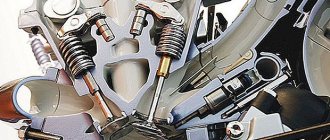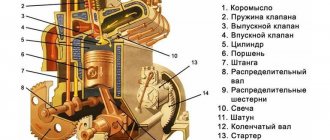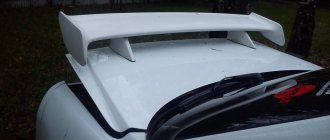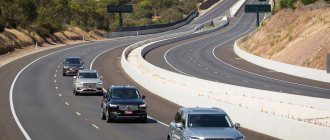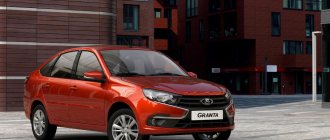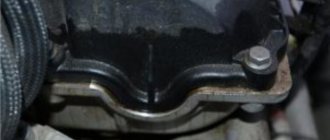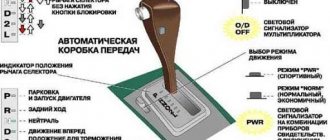What are the differences between drives: AWD, FWD, RWD and 4WD?
Modern cars use three types of drive: front-wheel drive (FWD), rear-wheel drive (RWD) and all-wheel drive (AWD). Front-wheel drive has become the most common; thanks to crossovers, all-wheel drive has become the second most popular, and rear-wheel drive cars are at the bottom of the ranking. But how are they fundamentally different from each other and which one is better?
Front wheel drive (FWD)
This type of drive is most widespread due to its simplicity and low cost. In such cars there is no need to pull the driveshaft under the floor, which increases usable space in the cabin. However, a small tunnel still remains on the floor; without it it is impossible to achieve the necessary rigidity of the body. Front-wheel drive has good road stability and handling. The disadvantages include the impossibility of installing sufficiently powerful motors, since during intense acceleration the load is transferred to the rear axle, which leads to the separation of the front wheels.
Rear-wheel drive (RWD)
All-wheel drive (AWD)
This type of all-wheel drive is most often used on crossovers. It allows you to ensure good stability of the car on the road in all weather conditions. Also, with all-wheel drive, you can safely drive off the asphalt and drive on moderate off-road conditions. All-wheel drive allows you to achieve good acceleration dynamics.
The disadvantages include the heavy weight of the transmission and not the best controllability in critical situations, as well as high fuel consumption.
Four-wheel drive (4WD)
Another type of all-wheel drive is 4WD. It has all the same advantages as AWD, but has a slightly different operating principle. Cars with such a drive are a symbiosis of front and rear drive. Drive to the rear wheels is transmitted using a cardan through a transfer case. This arrangement allows you to drive on difficult off-road conditions.
The disadvantage of such a drive is the large weight of the units and noise during their operation. The handling of such a car is quite mediocre. This type of drive is not very suitable for highway driving due to low speeds and high fuel consumption.
Source
Most drivers realize that the designations FWD or AWD refer to vehicles. However, only a few know for sure that this is an FWD drive. Let's take a closer look at what these concepts mean, in particular, what is special about the FWD drive, and whether it provides any advantages for the driver.
Cars with AWD
All car manufacturers implement their own engineering solutions when implementing AWD systems, which have their pros and cons, making them better or worse than their competitors.
Subaru
Uses the symmetrical AWD system that comes standard on all vehicles. The front and rear pairs of wheels share torque between themselves in a ratio of 60/40, in favor of the front ones, and the ratio can automatically change depending on the driving mode.
Honda
AWD is not widely used, only in a few models - Pilot, CR-V, and Crosstour. All use the VTM-4 system, one of the implementations of Haldex technology that only triggers when wheel slip is detected. Thus, if all wheels are spinning, the system does not have time to intervene to prevent slippage, negating all the benefits of AWD.
Toyota
It has a system similar to Honda, installed on the Highlander and RAV-4, called automatic drive with dynamic torque control. Under normal conditions, the engine is loaded only on front-wheel drive, which provides fuel savings compared to full AWD mode, but does not guarantee controllability in overload mode when maneuvering.
Acura
It has one of the most interesting solutions, called SH-AWD (all-wheel drive automatic with advanced control), the meaning of which is to transfer power to the wheel that needs it at the moment. For example, when turning with acceleration, torque is transmitted only to THREE wheels - two front and rear, describing an outer arc. This technology is used in the Acura RL/TL.
Audi
The Quattro is a good example of an outstanding AWD design concept. Audi uses two types of AWD systems - Haldex and Torsen. On cars of the TT series and newer, the Heldex system is installed, which occasionally connects rear-wheel drive. However, Audi enthusiasts prefer Torsen. Depending on the model and year of manufacture, the drive has a breakdown of the power supplied to the wheels in a ratio of 50/50 or 40/60 all the time, regardless of operating conditions, and eliminates slipping during any acceleration.
BMW xDrive
Uses Audi-based Quattro Torsen technology, characterized by the use of a 40/60 power split ratio in favor of rear-wheel drive at all times. This solution provides excellent steering and wheel control, for example in the BMW 335xi E90
Definition
From the very beginning, it is important to define the terminology, since many drivers and vehicle owners confuse AWD and FWD drives. Meanwhile, for four-wheeled vehicles, these terms practically mean the same thing. To summarize, AWD is an automatically connected (or permanent) all-wheel drive. 4WD is also all-wheel drive, which the driver can disable or engage manually.
Note that this terminology is not always followed in the automotive industry, so many buyers are often confused and do not always understand that this is an FWD drive. For example, Subaru Justy or Ford Tempo are marketed as AWD vehicles, although in reality the drive axles are engaged and disengaged manually.
The final confusion in the concepts is brought about by the all-wheel drive system, which can be connected if necessary (on demand four wheel drive). It is difficult to say what is at stake in this case. A similar concept can mean manually connected or automatic all-wheel drive. The press is largely responsible for this confusion, as it is the press that most often makes mistakes when publishing car reviews or press releases.
Pros and cons of AWD
Strengths of the technology:
- relative simplicity and low cost of design;
- fully autonomous control;
- the driver does not require special knowledge and skills;
- high fuel efficiency;
- programs work great on soil, sand, snow;
- the computer can predict problems in movement;
- much higher accuracy and speed of reaction to the situation;
- more gentle loads on the engine and transmission.
Weaknesses of All-wheel drive:
- no downshifts or differential locks;
- the program may make errors and inappropriate actions;
- the driver, as a rule, cannot influence the behavior of AWD in any way;
- the transmission, in most cases, is less reliable compared to 4WD;
- on the highway the car loses all the benefits of all-wheel drive;
- more limited capacity to transport goods;
- lower ground clearance and ground clearance compared to 4WD.
Thus, the choice between cars with 4WD and AWD directly depends on the conditions in which you plan to use the car. If you want an everyday car that you can use occasionally to get out into nature, then AWD is the perfect option. Well, for hunting or fishing trips into the depths of the wild, or for transporting goods along the remains of destroyed roads, only heavy SUVs or pickups with permanent all-wheel drive and a set of off-road options are suitable.
This is interesting: Choosing a car dealership to buy a KIA RIO car
Drive type FWD
The same concept can have different meanings. Each manufacturer uses one or another abbreviation to define all-wheel drive or front-wheel drive.
There are many options. In particular, the following abbreviations are popular:
As you already understand, it is impossible to say for sure that this is an FWD drive, since for different cars this concept can define different characteristics. Moreover, other prefixes may be attached to this abbreviation. It's common to find drivers or potential buyers who don't realize it's an LHD FWD. The first three letters stand for Left-Hand Drive, which translates to “Left-Hand Drive Vehicle.”
Types of FWD systems
There are different types of all-wheel drive transmissions. You can most often find adaptive all-wheel drive on SUVs, sports cars, crossovers, and even some minivans. This system is capable of distributing engine power between the rear and front wheels if necessary. In most cases, 100% of the power is sent to the front wheels first, but the system senses a loss of traction and shifts power to the rear axle. Moreover, power is not always distributed in a 50/50 ratio.
All-wheel drive is the simplest transmission system, which is implemented on SUVs such as the Jeep Wrangler and the Russian Niva. There is a special transfer case with which you can connect or disconnect the front axle from the transmission. That is, the car drives on rear-wheel drive most of the time, but when the driver notices a loss of traction, he can connect the front axle using a lever in the cabin.
Permanent all-wheel drive is rarely used in modern cars. Here, neither the driver nor the computer can connect/disconnect, or move the torque transmission to different axles.
Four-wheel drive
Note that sometimes the letters FWD mean a four-wheel drive vehicle (Full Wheel Drive). Cars with such a system are more expensive, and most often it is implemented in large jeeps, crossovers, and is rarely found in small cars.
Of course, all-wheel drive vehicles have better cross-country ability; they can easily pass through those places where a vehicle with one drive axle would get stuck for a long time and simply slip. Modern all-wheel drive technology is very advanced. For example, in most of these cars, the system initially loads the front axle, and when the computer notices even a slight deterioration in traction, it automatically transfers some of the engine power to the rear axle. As a result, the car does not lose dynamics and does not waste extra energy on slipping.
Also, due to all-wheel drive, the car is well controlled, especially when cornering. In any case, all-wheel drive is better, but such solutions are much more expensive.
When does FWD define front wheel drive cars?
Sometimes this abbreviation refers to transmission design. That is, FWD (Front-wheel Drive) can mean front-wheel drive if the manufacturer uses these three letters to define the type of transmission in which torque from the engine is transmitted to the front axle.
Therefore, it is impossible to say for sure whether FWD is front-wheel drive, rear-wheel drive or all-wheel drive. You can only exclude the rear one, but a car with a similar abbreviation in the transmission characteristics may turn out to be front-wheel drive or all-wheel drive.
The difference between 4WD and AWD
Generally speaking, AWD provides for automatically activated all-wheel drive, while in 4WD it is either permanent or can be connected and disabled manually. By the way, in auto topics, the not yet fully established terminology is sometimes violated, which confuses the consumer even more. For example, Ford Tempo and Subaru Justy at one time were “promoted” on the market as cars equipped with AWD, although in fact the functioning of the drive axles was adjusted manually. But in world practice there is also such a concept as on “demand four wheel drive,” i.e., a 4-wheel drive that can be connected if necessary. It is unclear from it who controls this system - a person or robotics. One way or another, the culprits for this “vinaigrette” are mainly the irresponsible media, which make blunders when publishing auto reviews, price lists and press releases, as well as Internet copywriters, who willingly or unwillingly distort information in the pursuit of uniqueness.
Part-Time 4WD appeared first and is the simplest and most reliable type of all-wheel drive
Previously, cars were overwhelmingly single-wheel drive, with a rear (less often front) drive pair. Then samples were created with a transfer case (“transfer case”). Through it, the thrust was distributed between the axles in the proportion established by the designers. This is how the first all-terrain vehicles appeared. Later, a number of versions of the all-wheel drive transmission were invented:
- Part-Time 4WD – partial all-wheel drive. Only short-term use of a system of this type is allowed, because on dry hard roads there is increased wear and failure.
- Full-Time 4WD – total non-switchable drive. The torque is continuously distributed between the axles in a ratio that has a constant value. In this drive mode, the car moves over arbitrary terrain, but to achieve truly off-road qualities it is equipped with rigid locking of the center and cross-wheel differentials.
- AWD – all-wheel drive operating in automatic mode. A computer or a viscose clutch determines the moment of wheel slipping independently, additionally connecting a second axle.
Pros of FWD
If we assume that FWD is the ability to send torque to all four wheels, then the benefits are obvious. In particular, this will provide better traction in bad weather or on rough terrain. The car is better controlled and takes sharp turns at high speeds more confidently. In addition, cars with two driving axles are more passable; where a vehicle with front-wheel drive gets stuck, an all-wheel drive car can easily pass.
Minuses
There are also disadvantages. The main one is the mechanical complexity of implementing such a system, which entails an increase in the cost of the car. Also, transmission failure can be much more expensive. Increased fuel consumption is another disadvantage of the FWD drive. The owners of such cars have no doubt that this is exactly the case. And the manufacturers do not hide this in the characteristics. Often in the technical parameters of vehicles you can notice that fuel consumption in an all-wheel drive car is higher by an average of 2-3 liters per 100 km. However, this is a fair price to pay for better cross-country ability, traction and handling.
What's better?
Many cars (including small SUVs and crossovers) are equipped with front-wheel drive only. This choice is suitable for drivers who travel around the city, but rarely leave it. However, even outside the city, most often you have to travel on smooth roads, but sometimes, of course, there are potholes and poor-quality road surfaces. Front- or rear-wheel drive cars can handle this easily.
All-wheel drive vehicles are designed for off-road driving, mud and potholes. They do a good job of this, but even good cars with a reliable suspension system and transmission can break down due to heavy loads. Often, users try to find front left wheel drive for Pontiac Vibe 2003 FWD or other spare parts for cars of other brands. As for sports cars, all-wheel drive is most often not needed at all. It's not for nothing that leading sports car developers make the rear axle driving.
The choice should depend on the region in which the driver lives. For example, if he lives in the north, where there is snow on the roads most of the year, then it is better to choose an all-wheel drive vehicle, as it will have better traction. This will provide not only riding comfort, but also greater safety due to improved handling. However, it is worth considering that on a dry road there is no noticeable difference in handling between a one- and all-wheel drive vehicle. This is clearly visible only on a slippery road, when driving over rough terrain.
Therefore, in urban conditions, Front Wheel Drive (FWD) is more justified. There is no need to “burn” extra liters of fuel, but this is true as long as the car is in the city and drives in moderate mode.
However, there is also an opposite opinion. Fans of all-wheel drive cars often point out that their handling is better. You can't argue with that. Consequently, such cars take turns better and make this process more predictable. At the same time, the driver of the car will feel comfortable and confident behind the wheel. You can even reduce your speed less before a turn, which will save energy and lead to less loss of torque during the next acceleration. Hence, in theory, fuel savings are possible. But these possibilities are rarely considered. Many drivers associate all-wheel drive with reliability. Such cars quickly start moving and accelerate without slipping.
What does AWD mean?
The abbreviation AWD stands for All wheel drive.
This is translated into Russian as “all-wheel drive.” As you can see, from the name it is not at all clear what the peculiarity of this technology is and how it differs from 4WD. But for an approximate orientation, you can use a small life hack: interpret the first letter A as “Automatic” and not “All”. Because AWD is primarily an automatic system that operates independently of the driver. This is what it looks like. Each wheel - or rather, the drive system of each wheel - is equipped with a variety of sensors and sensors. They measure the angular speed of rotation, the degree of wheel slip, and sometimes record the type of road (or off-road) surface. All this data is transferred to a computer, which analyzes it according to its program. And depending on the situation and the behavior of each wheel, the computer begins to dynamically distribute power and torque across the axles or even to each wheel separately.
Almost a third of modern crossovers and pickups are equipped with an AWD system. Typical models:
- Acura MDX;
- Honda Pilot
- Infinity FX;
- Mitsubishi Outlander;
- Hyundai Santa Fe;
- Jeep Grand Cherokee;
- Land Rover Freelander;
- Nissan Murano;
- Subaru Forester;
- Toyota RAV4;
- Audi Q7;
FWD (Front Wheel Drive): what is it and what is it for?
If we consider all the markings that exist today, you can make the wrong choice and purchase a car with completely different qualities than what was planned. After all, there are RWD and FWD drives with different descriptions, and which one you need is worth thinking carefully about.
FWD drive, what is it in a car? This abbreviation is not clear to many people. Therefore, this article will be devoted to the concept of FWD, what this component serves in a car and what advantages and disadvantages it has.
The abbreviation FWD and how to understand it
FWD is, as you probably already understood, a kind of drive. However, several concepts may be hidden under such an abbreviation. We will look at the main two of them. The first is Full Wheel, which means that all the wheels of the car are driven, that is, the car is all-wheel drive. And the second option is Front Wheel Drive, in which only the front axle is driven.
Today there is no clear concept of this type. But the main and often used one can be called FWD (Front Wheel Drive), which stands for front-wheel drive or all-wheel drive. Accordingly, this also applies to axles, either the drive is on the front axle only, or on two drive axles at the same time.
Advantages of front-wheel drive
1. In front-wheel drive cars, the engine is placed across the car, due to which the rotation of the crankshaft is immediately transmitted to the wheels.
It turns out that the number of torque adapters drops sharply, which cannot but be called an advantage for the operation of the equipment. 2. You can even be proud of the front drive axle with this configuration. After all, it takes the entire load of the car on itself, although the mass of the engine is considerable. In this case, it turns out that the driving axle itself and traction with the road are ensured in the best possible way.
Regardless of the weather, driving a front-wheel drive car will be much easier. It is controllable and obedient even in snow and ice. But owners should not increase the speed in such weather, as this risks causing the car to skid at speed.
3. As mentioned above, we owe front-wheel drive for the free space under the hood and even in the cabin, as well as the fact that the cost of such a car is more affordable than with rear-wheel drive.
Disadvantages of front-wheel drive
Despite all the advantages and laurels that front-wheel drive has received, the FWD drive type is still considered imperfect and has disadvantages.
A significant disadvantage is ensuring the safety of people in the car. After all, despite the fact that front-wheel drive versions of cars are not as susceptible to skidding as others, they still have the possibility of skidding. And in this case, it will not be very easy to level the car; it requires experience and dexterity; a beginner may not be able to cope.
To cope with front-wheel drive when skidding, experts advise immediately adding gas. Unfortunately, everything usually happens so quickly that drivers sometimes do not have time to react to the situation at the level of instincts. Under no circumstances should you brake to avoid losing control altogether. And if we take into account that with such a drive the wheels are rotary, then there will be a necessary limitation on the angle of rotation.
It is important to know that when picking up speed, part of the total weight of the car is transferred to the rear and the grip on the road surface deteriorates significantly. Because of this, slipping is inevitable if you own a car with FWD drive. Racing in such a car is contraindicated and deadly, no drifting will work on them! With sports cars, everything is different. The advantage of rear-wheel drive RWD is the presence of a rear drive axle, which allows you to drift. Or racing cars still use all-wheel drive.
Choice
Which drive is better - RWD, FWD, which one should you give preference to?
This has always been and remains a very pressing issue for many vehicle owners. Front-wheel drive FWD is still the leader today. According to experts and car owners, driving with a front drive axle is more convenient. Moreover, such an FWD drive is ideal for budget car models. As you can see, there is more trust in the FWD drive with a front driven axle.
When can choosing rear-wheel drive in a car be considered justified?
It is advisable to purchase a car with rear-wheel drive when your plans include purchasing a sports car. For daily movement in the city, the best option would be a car in which the front axle is still driven. That is why an impressive number of automakers strive to produce front-wheel drive models.
Rear-wheel drive is justified when it comes to choosing a sports car. In everyday city life, it is the car with the front drive axle that performs better.
Therefore, when choosing and purchasing a car, one cannot ignore the above factors and not take into account the advantages and disadvantages of the car’s drive. It is worth making your choice very carefully and taking into account its drive axle when driving on the roads. Perhaps, after reading this article, your choice will be made in favor of the FWD drive.
Rear wheel drive RWD
Rear-Wheel Drive is when power from the engine is transmitted only to the rear wheels. They rotate and push the car forward.
Here are the main advantages of a rear-wheel drive car. Firstly, it is simpler and more reliable. You have the engine in the front, the gearbox in the middle and the drive axle in the back, with the front axle doing the turning. On such a car, the steering wheel feels better; the drive does not affect the steering. Such cars have an advantage during acceleration and have controlled skidding of the rear axle. Most sports and racing cars are rear-wheel drive.
Flaws? RWD cars are bulkier and more expensive to produce. As a result, they have a higher retail price. The cardan tunnel “eats” the usable area of the car interior. There won't be enough space for three passengers in the back seat.
Advice for those drivers who have a front driven axle in their car
With your permission, we will try to give you some tips that will certainly be useful to you when operating your machine:
1. Do not forget that a car with front-wheel drive is very sensitive to steering wheel turns and is much better able to maintain straightness on the road. That is, the stability of your equipment on the road will be ensured. In winter, this named feature increases many times over. You are not afraid of snow, rain or ice.
However, drivers should not relax either, knowing that the car is obedient; there is no insurance against accidents. Remember that with lateral movement and wheel slip at the front, controlling your car will be extremely problematic.
2. We do not recommend racing on the track with front-wheel drive, because any sharp turns at high speeds will require very close attention from the driver. It is especially important to remember this during snowy periods of the year. A car in the snow tends to drive in a straight line and it is not always possible to calculate the turning radius, since in the snow and at speed it will actually turn out to be greater than one might expect and a skid will be inevitable, as well as an emergency situation.
Are there clear advantages to AWD technologies?
When comparing 4WD or AWD, we can highlight some disadvantages in all technologies. But for now we will try to focus on the benefits. There are many benefits to each all-wheel drive technology if you take advantage of them. For example, a trip around the city in the summer will not demonstrate any advantage of such technology.
But you will get the following advantages in a car with AWD:
- more confident operation of the car on the highway, significantly increased directional stability;
- a confident ride in difficult conditions, which allows you to get out of any trouble without help;
- the ability to move off the asphalt onto moderate off-road conditions when traveling to nature or fishing;
- you don’t need to configure anything, the electronics will perform all the assigned tasks for you without any problems;
- To save fuel, the system will automatically disable all-wheel drive when it is not necessary.
As you can see, this technology has many advantages. Of course, we are talking about AWD in isolation, without comparing the system with other all-wheel drive technology options. However, cars with such options have quite a lot of obvious visible advantages. So under certain conditions, paying extra for all-wheel drive will really be worth the money.
Optimal choice
Many drivers often wonder what the optimal choice of drive should be. It all depends on what goals the driver sets for himself. On what roads and with what frequency does he plan to drive his car?
Source
October 25, 2021 Category: Car secrets.
The engine is located at the front, torque is transmitted through the gearbox, driveshaft and axle to the rear axle of the wheels.
Today, RWD is found on older cars and some modern premium cars (BMW, Toyota), and is also installed on sports cars. Rear-wheel drive is especially appreciated by drifting enthusiasts.
Due to the fact that on a rear-wheel drive car, the front pair of wheels only sets the turning trajectory, its radius decreases, which allows the driver to successfully “fit” into the bends of the road even at high speed. The body of rear-wheel drive cars does not vibrate at all from engine operation, which increases passenger comfort.
Front-wheel drive is installed on the vast majority of modern cars.
The engine in vehicles with FWD can be mounted longitudinally or transversely mounted in front of, behind, or above the front axle.
There are three types of engine layout for front-wheel drive cars:
In any case, the main distinguishing feature of a front-wheel drive device is that the engine, gearbox, drive and differential are combined into a single unit for transmitting torque to the front axle.
This is both an advantage and a disadvantage of FWD : this solution is more profitable to manufacture, and the absence of a driveshaft allows for maximum use of interior space and reduces the overall weight of the vehicle. At the same time, the design of the unit itself becomes more complex, and the complexity of repairs increases.
In winter, because the weight of the engine loads the driven front axle, better traction is created. Therefore, front-wheel drive cars are recommended for beginners.
Due to the fact that the front wheels on FWD cars are overloaded (they transmit torque, control the vehicle's movement, and dampen road irregularities), and the center of gravity is shifted to the front axle, the maneuverability of front-wheel drive cars and acceleration dynamics leave much to be desired. When accelerating hard in a front-wheel drive vehicle, the front wheels may slip.
There are two types of all-wheel drive - permanent (Full-Time) and connected (Part-Time).
There is also “all-wheel drive on demand”, which is activated by a button in the cabin or by a control electronics solution. But it already belongs to the AWD .
Due to such a rigid engagement, the distribution of torque along the axes is the same.
Real SUVs (UAZ, Toyota Land Cruiser 70, Nissan Patrol, Suzuki Jimny), pickup trucks (Ford Ranger, Nissan Navara) and military equipment are equipped with this type of all-wheel drive.
Such cars have fantastic cross-country ability, but on asphalt they are rear-wheel drive vehicles that require special treatment. In particular, this type of all-wheel drive on paved roads results in reduced handling. High load on the transmission quickly damages it. Tires also wear out quite quickly.
This design contains both a center differential and cross-axle differentials for optimal distribution of transmitted power to each wheel. And the center differential is also accompanied by a locking mechanism, which increases the vehicle's cross-country ability.
The optimal distribution of torque across the axles and wheels gives the car excellent directional stability, especially when cornering.
Fuel consumption on all-wheel drive vehicles is significantly higher due to the loss of power in transmitting torque to two axles at once.
In general, all-wheel drive today serves as more of an expensive option on premium cars.
As in the case of the Part-Time drive, the second axis is connected here on demand, but here to fulfill the requirement it is enough to activate the corresponding mode by pressing the button in the cabin. Another option is when the second axle is connected automatically when the wheels of the leading axle slip.
As a rule, the main driving axle is the front one, and if necessary, all-wheel drive is connected, and the torque begins to be transferred to the rear axle in a ratio of basically 60/40 to the front/rear axle.
This is realized by means of an interaxle coupling. There is no differential, and due to the fact that a hydraulic or electromagnetic clutch allows the axles to slip, the vehicle's handling in all-wheel drive mode is improved.
A special feature of cars with AWD is “fool proofing”. That is, the owner can block the clutch before a difficult section of the road so that the all-wheel drive remains engaged, but if the electronics determines the speed to be higher than safe for a given driving mode, the clutch can unblock itself.
AWD is found everywhere on crossovers such as Renault Duster, Nissan Terrano, Mitsubishi Outlander, Toyota RAV4, Kia Sportage, etc. The popularity of this type of drive is only growing.
How does AWD work?
A typical All-wheel drive operating scenario is as follows. Imagine that you are driving along a normal road, even with bumps and puddles, but still far from off-road. It is clear that in such conditions all-wheel drive is useless, because it causes increased fuel consumption. Front-wheel drive is quite sufficient - it is both economical and provides good handling.
It's a different story when you pull onto a dirt road, especially if it's recently rained and the dirt has turned to mud. On two driving wheels you can thoroughly “sit down” in some hole or puddle. Therefore, the AWD on-board computer automatically connects the rear wheels, transferring part of the engine power to them. The car becomes all-wheel drive. But here there are some differences from traditional all-wheel drive vehicles.
Traditional all-wheel drive technology, 4WD, typically distributes power equally between the axles and wheels. In the case of AWD, the front axle almost always gets the most power, accounting for 60 to 90 percent of the engine's power and torque. Only a few manufacturers like Audi and Subaru provide the usual equal (50/50) distribution between the axles.
Another difference from 4WD is the absence of low gears and the possibility of differential locks. Many off-road enthusiasts do not like this lack of “adult” options, and their indignation is well founded. After all, a lower gear significantly increases the power supplied to the wheels, and differential locks prevent wheel slipping. Without these functions, attacking serious off-road conditions is quite reckless.
When driving off a paved road in an AWD vehicle, remember that the success of your trip depends mainly not on your driving skills, but on the quality of the on-board computer program. Some manufacturers bring elements of traditional 4WD to All-wheel drive by providing manual control, but this is rare. In general, AWD is perfect for driving on light off-road conditions, but not in remote, deep swamps.

